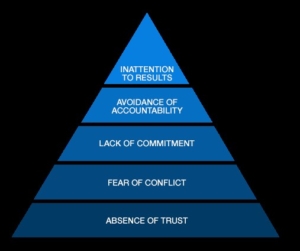I have a dream. Wouldn’t it be great if we all worked in teams that have no politics nor dysfunctions so that we can get our work done and focus on the desired results? Please be aware: If you want to make teams effective, it does require high levels of courage and discipline.
Teamwork is the ultimate competitive advantage in today’s business world. Improving teamwork is not only a critical leadership endeavor, it also reduces the degree of stress and dissatisfaction of the people in organizations, which – if not addressed – can cost the company an extensive amount of money.
How can you actually develop a team to be cohesive and operate functionally? What does it take to get to that state? While I was chewing on these questions, I discovered the book „The Five Dysfunctions of a Team” by Patrick Lencioni. The greatest take-away for me is that these five dysfunctions are pervasive in all kinds of organizations and teams that I have worked with. It seems difficult to nail down the exact root causes of the observable symptoms, but this book provides just that. By identifying and naming the dysfunctions, each team member can now be on the lookout for them. Over time, they can learn to address the root causes that keep them from reaching their full potential. Through this approach I have helped various teams become more functional and cohesive and less political.
No team is perfect and even the best teams sometimes struggle with one or more of these issues. Hence, I recommend that teams walk through a reflection process based on the five dysfunctions once a year. Without reflection, the likelihood increases that your team starts struggling again with one of the five dysfunctions.
What are those dysfunctions? Let’s have a closer look.

(©The Table Group, Inc. All rights reserved.)
- Dysfunction #1: Absence of Trust
The fear of being vulnerable with team members prevents the building of trust within the team. - Dysfunction #2: Fear of Conflict
The desire to preserve artificial harmony stifles the occurrence of productive ideological conflict. - Dysfunction #3: Lack of Commitment
The lack of clarity or buy-in prevents team members from making decisions they will stick to. - Dysfunction #4: Avoidance of Accountability
The need to avoid interpersonal discomfort prevents team members from holding one another accountable. - Dysfunction #5: Inattention to Results
The pursuit of individual goals and personal status erodes the focus on collective success. (©The Table Group, Inc. All rights reserved.)
Now what? What are the benefits of dealing with those dysfunctions? Imagine how members of truly cohesive teams behave:
- They trust one another.
- They engage in unfiltered conflict around ideas.
- They commit to decisions and plans of action even if they don’t agree because they were heard and involved emotionally into the discussion.
- They hold one another accountable for delivering against those plans.
- They focus on achieving collective results.
If that happens: A dream becomes true, and this is a very powerful moment!
„impulsraum“ partners with Inspired Executives to help organizations create many of the aforementioned powerful moments. Contact Annette or myself for a free consultation.
